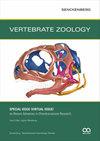下白垩世高古纬度Teete地区(俄罗斯东部雅库特)的哺乳动物岩石化石
IF 2.3
2区 生物学
Q1 ZOOLOGY
引用次数: 3
摘要
摘要:雅库特(俄罗斯)下白垩纪Teete地区的一种哺乳动物岩化石在耳蜗部骨壁上显示出一个突出而复杂的静脉通道系统,该系统围绕着直耳蜗管。这种复杂的静脉系统是独特的,比其他哺乳动物的岩状系统发育得更强。骨嵴存在于耳蜗管内支架的腹侧,从前庭窗和耳蜗窗之间向前延伸。该嵴对应于鼓阶的位置,类似于牙冠的次级骨板,但缺乏尖锐的板边缘。耳蜗开窗与耳蜗水引管(衍生)的管是分开的,但开窗保留了一个类似于外淋巴沟的深沟(近似)。耳蜗窗呈椭圆形,深。腹侧有脊的直蜗管与北美洲上侏罗纪的真脊灰蝶(Priacodon fruitaensis)非常相似。然而,从牙形石中可以发现耳蜗部的厚而广泛的静脉通道。在Teete岩系中,通道更加发达,类似于最近报道的西伯利亚西部侏罗纪中期可能的haramiyidan岩石断裂的模式(俄罗斯)。除了三齿龙和多齿龙外,Teete地区还发现了eutricodontan和haramiyidan的牙齿遗骸。本文章由计算机程序翻译,如有差异,请以英文原文为准。
Mammalian petrosal from the Lower Cretaceous high paleo-latitude Teete locality (Yakutia, Eastern Russia)
Abstract
A mammalian petrosal from the Lower Cretaceous Teete locality in Yakutia (Russia) shows a prominent and complex system of venous channels in the bony wall of the pars cochlearis surrounding the straight cochlear canal. This complex venous system is distinctive and more strongly developed than in other mammalian petrosals. A bony ridge is present on the ventral side of the cochlear canal endocast, continuing from between fenestra vestibuli and fenestra cochleae in anterior direction. This ridge corresponds to the position of the scala tympani, and is similar to the secondary bony lamina of crown therians, but lacks the sharp laminar edge. The fenestra cochleae is separate from the canal for the aquaeductus cochleae (derived), but the fenestra retains a deep sulcus that resembles the perilymphatic sulcus (plesiomorphic). The fenestra cochleae is oval shaped and deep. The straight cochlear canal with a ridge on the ventral side strongly resembles that of eutriconodontans like Priacodon fruitaensis from the Upper Jurassic of North America. However, thick and extensive venous channels in the pars cochlearis are otherwise known from docodontans. In the Teete petrosal the channels are even more developed, and resemble the pattern recently reported from possible haramiyidan petrosals from the Middle Jurassic of western Siberia (Russia). Both eutriconodontan and haramiyidan dental remains are known from the Teete locality beside that of tritylodontids and docodontans.
求助全文
通过发布文献求助,成功后即可免费获取论文全文。
去求助
来源期刊

Vertebrate Zoology
ZOOLOGY-
CiteScore
4.00
自引率
19.00%
发文量
42
审稿时长
>12 weeks
期刊介绍:
Research fields covered by VERTEBRATE ZOOLOGY are taxonomy, morphology, anatomy, phylogeny (molecular and morphology-based), historical biogeography, and palaeontology of vertebrates.
 求助内容:
求助内容: 应助结果提醒方式:
应助结果提醒方式:


